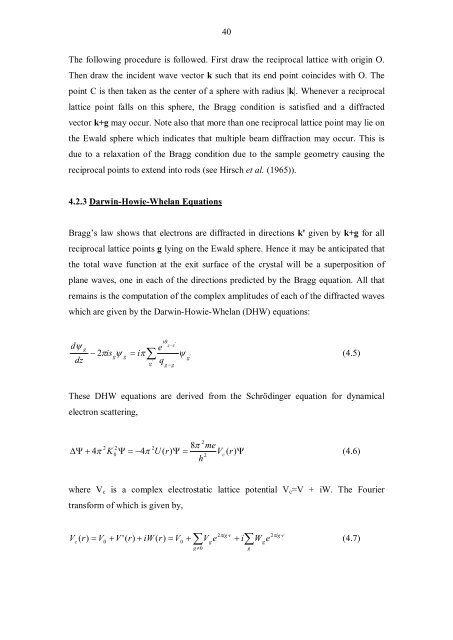Analysis of the extended defects in 3C-SiC.pdf - Nelson Mandela ...
Analysis of the extended defects in 3C-SiC.pdf - Nelson Mandela ...
Analysis of the extended defects in 3C-SiC.pdf - Nelson Mandela ...
You also want an ePaper? Increase the reach of your titles
YUMPU automatically turns print PDFs into web optimized ePapers that Google loves.
40<br />
The follow<strong>in</strong>g procedure is followed. First draw <strong>the</strong> reciprocal lattice with orig<strong>in</strong> O.<br />
Then draw <strong>the</strong> <strong>in</strong>cident wave vector k such that its end po<strong>in</strong>t co<strong>in</strong>cides with O. The<br />
po<strong>in</strong>t C is <strong>the</strong>n taken as <strong>the</strong> center <strong>of</strong> a sphere with radius |k|. Whenever a reciprocal<br />
lattice po<strong>in</strong>t falls on this sphere, <strong>the</strong> Bragg condition is satisfied and a diffracted<br />
vector k+g may occur. Note also that more than one reciprocal lattice po<strong>in</strong>t may lie on<br />
<strong>the</strong> Ewald sphere which <strong>in</strong>dicates that multiple beam diffraction may occur. This is<br />
due to a relaxation <strong>of</strong> <strong>the</strong> Bragg condition due to <strong>the</strong> sample geometry caus<strong>in</strong>g <strong>the</strong><br />
reciprocal po<strong>in</strong>ts to extend <strong>in</strong>to rods (see Hirsch et al. (1965)).<br />
4.2.3 Darw<strong>in</strong>-Howie-Whelan Equations<br />
Bragg’s law shows that electrons are diffracted <strong>in</strong> directions k' given by k+g for all<br />
reciprocal lattice po<strong>in</strong>ts g ly<strong>in</strong>g on <strong>the</strong> Ewald sphere. Hence it may be anticipated that<br />
<strong>the</strong> total wave function at <strong>the</strong> exit surface <strong>of</strong> <strong>the</strong> crystal will be a superposition <strong>of</strong><br />
plane waves, one <strong>in</strong> each <strong>of</strong> <strong>the</strong> directions predicted by <strong>the</strong> Bragg equation. All that<br />
rema<strong>in</strong>s is <strong>the</strong> computation <strong>of</strong> <strong>the</strong> complex amplitudes <strong>of</strong> each <strong>of</strong> <strong>the</strong> diffracted waves<br />
which are given by <strong>the</strong> Darw<strong>in</strong>-Howie-Whelan (DHW) equations:<br />
d<br />
dz<br />
g<br />
2is<br />
<br />
g<br />
g<br />
i<br />
i<br />
g g<br />
'<br />
e<br />
' g q '<br />
g g<br />
<br />
'<br />
g<br />
(4.5)<br />
These DHW equations are derived from <strong>the</strong> Schröd<strong>in</strong>ger equation for dynamical<br />
electron scatter<strong>in</strong>g,<br />
2<br />
2 2<br />
2 8<br />
me<br />
4 K 0 4<br />
U ( r)<br />
V ( r)<br />
<br />
2 c<br />
(4.6)<br />
h<br />
where Vc is a complex electrostatic lattice potential Vc=V + iW. The Fourier<br />
transform <strong>of</strong> which is given by,<br />
V ( r)<br />
V V<br />
'(<br />
r)<br />
iW ( r)<br />
V<br />
c<br />
0<br />
0<br />
<br />
2igr<br />
Vg e i<br />
g0 g<br />
W<br />
g<br />
e<br />
2igr<br />
(4.7)

















